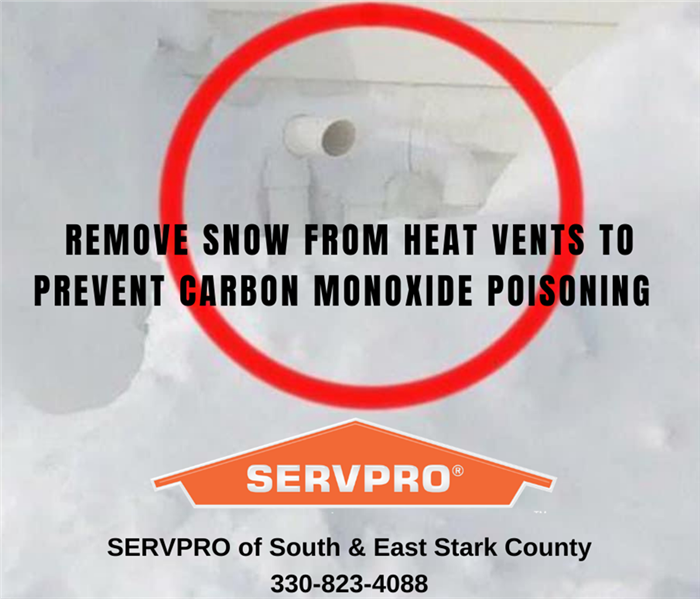SERVPRO Winter Storms Safety Tips to Prevent Carbon Monoxide
2/17/2021 (Permalink)
Snow Accumulation Can Block Ventilation
With this recent storm the weather conditions make for double trouble for gas meters and heat vent pipes in new high efficiency furnace installations. Significant snow that is blowing and drifting, and we have arctic temperatures that require heat to run almost constantly. Please check you gas meter and heat vent pipes regularly to be sure they are free from snow and ice. If blocked, carbon monoxide can quickly fill a house creating a life-threatening hazard. When a snowstorm hits, carbon monoxide (CO) becomes a threat if exhaust vents for appliances and engines get covered up by snow.
Follow these tips to prevent Carbon Monoxide Poisoning:
- Improperly ventilated appliances and engines, particularly in a tightly sealed or enclosed space, may allow carbon monoxide to accumulate to dangerous levels. The snow was cleared from the vent pipe and the CO readings dropped. Homeowners can prevent carbon monoxide by being proactive about clearing the vents for the dryer, furnace, stove, and fireplace of any snow.
- If you need to warm-up a vehicle, remove it from the garage after starting it. Do not run it indoors for an extended period, even if garage doors are open.
- Turn on generators in a well-ventilated location outdoors away from windows, doors, and vent openings to prevent any exhaust (CO) from entering the structure.
- Remove all snow and ice from heat vents from your house.
These methods are vital to prevent the effects of CO exposure, which varies by the victim’s health and activity level and enters the body through breathing. Infants, pregnant women, and people with emphysema, asthma, heart disease can be more severely affected by lower concentrations of CO than healthy adults.
Carbon Monoxide poisoning can be confused with flu symptoms, food poisoning and other illnesses. Some symptoms include:
- Shortness of breath
- Nausea
- Dizziness
- Lightheadedness
- Headaches
High levels of CO can be fatal, causing death within minutes. The danger increases for people sleeping or intoxicated and can cause brain damage or death before anyone realizes that they have been poisoned. It is important to install a CO detector in your home. If you already have a CO detector, check your batteries, test your alarm monthly and replace according to manufacturer’s instructions, usually every seven years. If your alarm sounds, call the fire department and move outdoors or by an open window or door. Due to the invisible nature of carbon monoxide, alarms should never be unplugged.






 24/7 Emergency Service
24/7 Emergency Service
